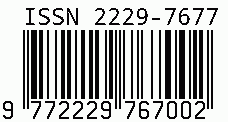
International Journal on Science and Technology
E-ISSN: 2229-7677
•
Impact Factor: 9.88
A Widely Indexed Open Access Peer Reviewed Multidisciplinary Bi-monthly Scholarly International Journal
Plagiarism is checked by the leading plagiarism checker
Call for Paper
Volume 16 Issue 4
October-December 2025
Indexing Partners



















“Free radical scavenging by DPPH method of Annona muricata ethanolic leave extract with metallic conjugates and its anti- bacterial activity”
| Author(s) | Ms. Manshi Anand, Dr. Ankur Chhari, Dr. Alibha Guru, Ms. Shivani Deshmukh, Ms. Pratima Sharma, Mr. Sarfaraz Hanfi |
|---|---|
| Country | India |
| Abstract | Background: The aim of this study is to analyze the antioxidant properties and antibacterial efficacy of ‘Soursop’ A. muricata L. ethanolic leave extract with its Iron and Copper nanoparticles against gram negative and gram positive bacteria. A. muricata L. extract-mediated green synthesis proposed in this work is a fast, economical and effective technique to synthesize NPs with promising antibacterial activity a well published work done by (Vidhya. S, et al., 2022) Methods:In this study, we used known gram positive (Staphylococcus aureus and Streptococcus mitis) and gram negative bacteria (Escherichia coli and Klebsiella pneumoniae) to analyse the Antibiotic susceptibility testing by using ‘Disc diffusion method’ and ‘Agar well diffusion’ method. Experiments performed: Known bacterial culture was used on different agar medium like NAM, MHA, McC, for anti-microbial susceptibility testing of ‘Soursop’ leaves extract and its conjugates (FeNP & CuNP) compared with known antibiotics. Result: Ethanol extract of Annona muricata L. showed good antibacterial activity. Among the selected solvents and prepared metallic conjugates with FeCl3 and CuSO4 all of these exhibited significant (mild to moderate) antibacterial effect on selected known bacterial strains by using Nutrient Agar and similar zone were measured on Muller-Hinton agar. Charcoal filter (CH) extract shows moderate effect against selected Gram positive & negative bacteria. Conclusion: In our study we used ethanolic extraction and aqueous ethanolic 50% EtOH in another group as per modified method adapted from (A. Hussain, et al., 2019) the aqueous ethanolic extraction shows maximum yield as it extracted water as well as alcohol soluble phyto-compounds of A. muricata leaves. The disk diffusion method & Agar well diffusion method was appropriate only as a preliminary screening test prior to MIC determination with the dilution method. S. aureus and E. coli were the most tested microorganisms belong to Grams positive & negative category. |
| Keywords | Annona muricata L, Gram positive & negative bacteria, nanoparticles, antioxidant. |
| Field | Biology > Genetics / Molecular |
| Published In | Volume 16, Issue 3, July-September 2025 |
| Published On | 2025-07-13 |
| DOI | https://doi.org/10.71097/IJSAT.v16.i3.7015 |
| Short DOI | https://doi.org/g9s9vr |
Share this


CrossRef DOI is assigned to each research paper published in our journal.
IJSAT DOI prefix is
10.71097/IJSAT
Downloads
All research papers published on this website are licensed under Creative Commons Attribution-ShareAlike 4.0 International License, and all rights belong to their respective authors/researchers.

